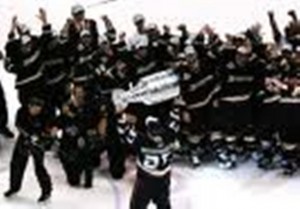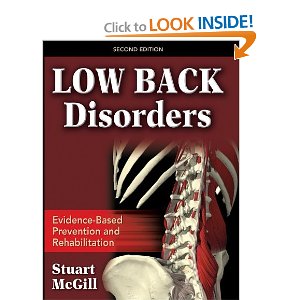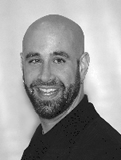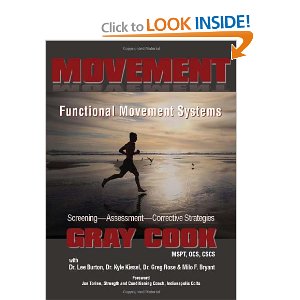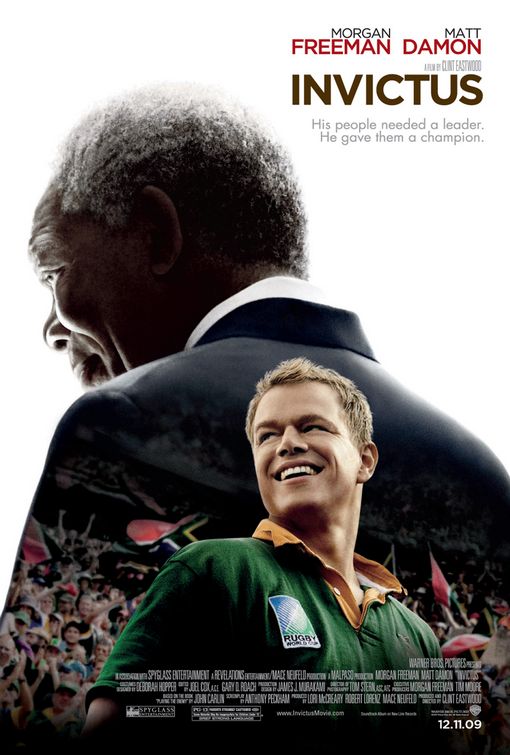Jack Lalanne passed away last night at the age of 96. He is a true legend when it comes to the fitness field and lifestyle. I honestly thought he would live another 10-20 years or so.
I don’t know when this video was shot, but since it is in black and white, I would say it was a long time ago. Please do me a favor and take 3 minutes out of your day to watch this clip. Jack is right on the money here.
When it comes to fitness, I think it is important to do something everyday to help you achieve your goals. It doesn’t have to be a 2-hour workout consisting of strength training and conditioning. It could be as easy as a 20 minute walk or as hard as a kettle bell workout. It all depends on your current level of fitness. For some, maybe it is getting off the couch and doing some house work or riding the stationary bike for 30 minutes? Either way, do something to get moving.
When I think of the athletes that I am fortunate to work with, they rarely get total days off to rest. Usually it is a game, practice, travel day, or a strength and conditioning session that helps keep them busy. It is also why hockey players may be the most “fit” athletes.
Speaking of doing something everyday day, I’ve spent some time recently updating the blog. With the help of Kevin Neeld, I think I’ve made the site look better and I have also added a Recommended Resources page and a Testimonial page. Check them out. Thanks! Sean
A discussion on the most recent episode of the StrengthCoachPodcast inspired me to write this post. Anthony Renna and Mike Boyle were discussing goal setting and how important it is to write down your goals. If people like Anthony and Mike are advocating goal setting, I think it is worth trying it out. Goal setting is crucial for attaining success.
Writing your goals down has been promoted by several of the self-help gurus for years. I have been personally writing down my goals now for 4-5 years and all I can say is that it works. I really can’t imagine not having goals.
At the beginning of 2010, I had a list of goals that I wanted to accomplish. Although I personally didn’t achieve all of them, I did get to achieve most of the goals that I set. I really believe that if I didn’t set these goals and develop a plan for achieving them, I wouldn’t have accomplished them.
When I actually set them, I wrote them down on a daily basis in my notebook. I wrote them as if I already had achieved them. What happened was that the more I wrote them down, the more I believed that I was going to accomplish them. I felt like I was going to be unproductive if I didn’t achieve them.
From a professional standpoint, the Stanley Cup is always the goal. 30 teams in the NHL begin each season with this goal in mind. Even though this is a big goal every year, it is probably the most difficult trophy to win in all professional team sports. I am realistic to know that there are so many factors that come into play for winning the cup. As a result, I don’t feel as unproductive if we don’t win it. I also wish I could write down my goal of winning the Cup everyday and win it in June.
Some of my personal professional goals for 2011 include continuing to update this blog more frequently, developing an information product for hockey, speaking at more at seminars and conferences, writing more articles, and continuing to grow HockeySC.com.
As a strength and conditioning coach, I believe it is important to be as strong and conditioned as you can be. Although pro hockey players are some of the most fit people in the world, I don’t think it is unreasonable for a strength and conditioning coach who works with them to try his best get to their levels. I do have some physical goals that I look to improve in 2011.
Now that I have written my goals down, I will be writing all of them down on a daily basis and coming up with a plan to achieve all of them. I really have zero excuses.
What are your goals for 2011?
A Facebook post by Kyle Holland from MBSC got me thinking recently about the number of websites and blogs out there in the Strength and Conditioning industry. Obviously, the one you are reading is one of them. This blog is now almost 2 years old and I still have a hard time with “shipping”- (a term I learned from reading Seth Godin’s material). Sometimes I think I need to post really great content or nothing at all. Don’t know if the content has been great, but I guess I’ve learned to not care too much of what anyone else thinks.
There is a ton of great information being shared on the internet. I really like blogs that are about what the author is thinking at that present time. Coaches and Trainers who are trying exercises and programs with their athletes/clients and themselves and sharing it via blogs and social media platforms is great for the field.
I first read the article, the The Business by Alwyn Cosgrove and Jason Ferruggia a few years ago. This article hits the nail on the head. Although I do know Alwyn personally, I’ve never met Jason before. These guys are great writers and I know that before they even wrote an article, they were great trainers who got real results with their athletes/clients. If you haven’t read it, please do.
Will I sell an information product someday? Yes, I would like to write a hockey training book amongst other projects. Stay tuned.
I am actually writing this blog on my ipad at a Starbucks in Anaheim Hills on a rare rainy day. I really enjoy the ipad as I get to write blogs like this, write articles, read articles, listen to podcasts, and watch tv shows and movies.
One recent article that I have read is Dan John’s article on T-nation- “The More You Lift, The Worse You Look.” This another great piece that he has put together. I don’t know what it is specifically that I like about his writings. What I think makes me enjoy his work is that the information is great once it is applied to your athletes training or my own. I can’t even count how many times I will read his articles or re-read his book Never Let go and ask myself “Why didn’t I think of that?”. I only know of Dan the writer. I am sure he is an outstanding person and Strength and Conditioning Coach.
What I like about this article is that he brings about some great points about muscles and exercises that can often be neglected by people in their training today. The mirror muscle mentality is prevalent amongst people trying to improve themselves whether it is for athletic performance or aesthetic purposes.
There is so much stuff out there in Strength and Conditioning today. Sometimes it can get confusing. When do I do this exercise? What is the progression or regression? What Dan does so well is give common sense advise that can be applied daily to help attain big results. I have actually already incorporated the stretches and the rhomboid rows with myself and some of my athletes.
On Friday, August 6th, I made it up to Long Beach for the Perform Better Summit. Yes, this is the second summit I attended this summer. Honestly, I really can’t get enough of learning from the people at these events or meeting up with friends who I don’t get to see that much. With the season coming up, continuing my education during the summer months is a priority. At these seminars, I think it is important to not only pay attention and take notes, but more importantly to bring the information home with you and take action with applying the information that you learned.
I actually went to this one because Stuart McGill wasn’t in Providence and I didn’t get to see Gray Cook there. Both speakers didn’t disappoint. I like to list all of the key points that I took away because I feel that I can learn more by typing about it. Here is a brief summary of what I got from each speaker who I was lucky enough to see:
Stuart McGill- Dr. McGill was one of the main reasons why I went to this summit. What I really enjoy and respect about Stuart is that he is doing his research on real-world athletic populations. I also like that it isn’t uncommon to see him in other talks at the summit. This shows me that he has the beginners mind and is just as interested in what others are saying as people in his lectures are of him. Here are some of the key points that I took away:
– The spine needs to bend, but is limited in the number of bends
– Sparing the spine through training will lead to a higher tolerance of training
– Tolerance is the load tissue can take before it can get damaged, find training load just under tolerance
– Rectus abdominis is designed to be “spring-like” with elastic storage
– According to Stuart, from practical observations of high school football teams doing power cleans, only 30% of athletes he saw were able to do correctly. (I totally agree with him as I have seen some ugly forms of power cleans early on in my career)
– “We work with motions, postures, and loads. Motions, postures, and loads cause injury. Motions, postures, and loads prevent injuries.”
– “Can’t have a stable back with stable hips.”
– “Can’t mix up getting rid of pain and increasing performance.”
– Stuart hates squatting with a stability ball between the legs. This immediately inhibits the glutes. (From my earlier posts, you can see that I agree with Stuart on this as well).
– Exercise ideas- “Stir the pot”, and suitcase carries for Q.L.
– “Spare the back!”
Brian Grasso- I’ve never seen Brian speak before and he didn’t disappoint. This wasn’t your usual training or scientific based lecture. This was about personal success and self-improvement. Brian’s talk was inspirational and motivational to me as he mostly spoke about himself and what he has done so far in his career and life. He wasn’t bragging, he was just stating the facts. I walked away impressed with Brian as a person. You can find out more about Brian at www.developingathletics.com
– Be more regimented. Know exactly how your day will go.
– Assess when you are at your best.
– “The more skills you have- the more potential you have.”
– Goal setting- The whole pie syndrome- complete small, bite size tasks to achieve your goal
– The Kaizen principle- small incremental changes lead to great change over time
– Have high expectations for yourself
Gray Cook- I think Gray is an excellent presenter and one of the smartest guys I’ve ever listened to. I really believe that the movement screen (FMS) is a good tool. I know that there are some people out there with negative views on the FMS, but I really think it is something that can give us as strength and conditioning coaches- (especially those in the team environment) valuable information. I am the type of strength and conditioning coach who looks at things from a perspective of trying to maintain the health of our players. By the way, if you haven’t picked up his new book Movement: Functional Movement Systems: Screening, Assessment, Corrective Strategies, you should- I am currently reading it right now.
What I really enjoy hearing about is what people are doing with the FMS from a practical standpoint. For example, some strength and conditioning coaches in the NFL have done extensive work with the FMS. Jon Torine from the Colts and Jeff Fish from the Falcons use the FMS and corrective exercises with their teams. Both of them have participated in studies which validate the FMS and correctives as a system that can help their teams. If a strength and conditioning coach can use the FMS with success with their team, then why wouldn’t I try it with the team that I work with? To me, it makes no sense to not use it. Is it the main aspect of our program? – No. However, it only takes 5-10 minutes to go through a screen and it may show a player and me some potential problems. Here are some main points that I took away from Gray’s talk:
– Movement is a behavior
– Injuries occur when physical capacity exceeds movement
– Stiffness isn’t stability
– Biomarkers for injury risk-
- Previous injury
- Asymmetry
- Motor Control
- BMI
- Stupidity
– Possible to be pain free, but dysfunctional
– FMS intervention study- Falcons- FMS scores increased
- 7 week off-season program
- Based on FMS individual scores
- Movement prep+corrective exercises added
- Movement prep examples- stick work, isolated stretching
- Worked on worse movement pattern
– Score of 14- breakpoint for injury
– 2’s with no asymmetries- good
– Best way to strengthen the core- remove deficiencies
– Dynamic Stability Training- KB Swing, Indian club swinging, Chop and Lifts with Med ball
There you have it. I stayed for a day and a half as I had to make it back to Orange County to train with a client on Saturday morning. Although I wish I got to stay longer, I feel that the information that I got from both summits in Providence and Long Beach was enough to keep my head spinning with new ideas and concepts for a long time.
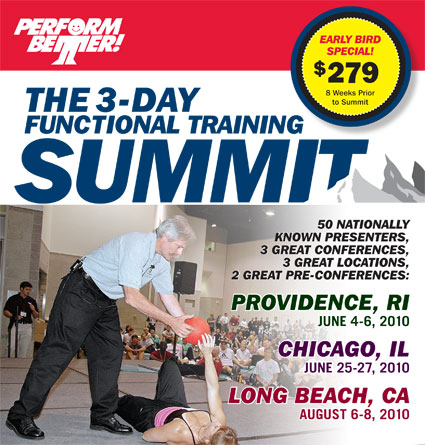 The 2nd day of the Perform Better Functional Training Summit started at 8am on Saturday. Here is the lineup of all the speakers and some of the information that I got from the day:
The 2nd day of the Perform Better Functional Training Summit started at 8am on Saturday. Here is the lineup of all the speakers and some of the information that I got from the day:
Todd Wright- Todd is the Strength and Conditioning Coach for Men’s Basketball at the University of Texas. Todd is a guy who has an unbelievable passion for learning and helping his guys get better. Todd is highly influenced by Physical Therapist Gary Gray and his organization’s methodology. He is also an entertaining speaker who is pretty funny. Here are some of the things that I took from his talk:
– Locomotion is the ability to get from A to B using a variety of specific movement patterns that will allow you to accomplish the task most efficiently
– Although the primary patterns of locomotion are walking, running, shuffling, skipping, and carioca, the possibilities of progressions and variations are endless
Chris Frankel- Chris is the Director of Programming for Fitness Anywhere, the makers of the TRX. Although I have been using the TRX for a few years now, I’ve never been able to see Chris speak on the concept of suspension training. Chris did a great job both in the lecture and the hands-on sessions. Here are some of the keys that I got from both:
– Chris describes work as “high intensity interval training built on strong focused movements.”
– When doing a plank, or whenever you are holding yourself against gravity (such as with the TRX), you should focus on flexing your trunk, extending your trunk, side bending your trunk to the right, and side bending you trunk to the left, to create stability.
– The TRX is basically performing moving planks
Greg Rose- Greg is with the Titleist Performance Institute where they primarily work with golfers. This was a highlight for me because I have seen Greg speak before and was really impressed. His ability to evaluate movement in the golf swing and prescribe exercise strategies to prevent pain is remarkable. His speech is one of the main reasons why using a foam roller (especially a vibrating one) has helped me get out from the miserable state of the back pain I was having a few months back. I truly think that all strength and conditioning coaches should try to do this the best that they can with their athletes. Preventing injuries and/or rehabilitating injuries go a long way with clients. Greg is a pioneer in training for golf and I was glad I sat in this lecture. I am already looking forward to visiting with Greg at the institute in Oceanside, Ca this summer. Here are some of the keys that I took away:
– The number 1 injury in non-contact rotary athletes is compensation
– The key to controlling back pain from the golf swing is managing the hip and t-spine areas. (Do we see a pattern here?)
– There are 3 postures in the golf swing- The N posture, the S posture, and the C posture
– The reverse spine angle in the golf swing is the leading cause of back pain
– Never bring a mobility problem to a stability correction
– The inability to disassociate the hip and t-spine leads to injury
Sue Falsone- Sue is a Physical Therapist who works at Athlete’s Performance and with the Los Angeles Dodgers. She spoke on the Thoracic Spine, an area that she is passionate about and an area that I need to know more about. Here are some key points I got from Sue’s talk:
– When using the 2 tennis balls taped together for t-spine mobility, it is better to think about making anterior to posterior movements rather than simple rolling over the balls
– The t-spine has to move in order for our arms to move
– A great pec minor release that Sue showed was with a tennis ball against a wall where there is pressure applied between the wall and pec minor with an emphasis on scapula depression.
– Respiration is automatic, breathing is conscious
That was it for Saturday. It was another outstanding day of learning. Sunday, I stuck around for both a lecture and hands on by Thomas Meyers.
Thomas Meyers- Last, but certainly not least was Thomas Meyers. Thomas is the author of Anatomy Trains, a great book that describes the myofascial system. I think most of the attendees at the Summit stuck around just to see Thomas speak. Through his book and his lecture, Thomas gets you to look at things from a different perspective. I learned tons of information from the lecture and hands on. I am already thinking about how I am going to incorporate some of the line (frontal, posterior, lateral, and spiral) stretches into my training system. Here are some of the key points from both the lecture and hands on:
– Habit requires posture. Habits can’t be changed easily. Postures require structure- fascia
– Fascia has a proprioceptive emphasis and is 10 times more sensitive than muscle. There are 9 times more receptors in fascia than there are in muscle.
– Foam rolling and dynamic warm ups are good for turning on receptors
– “The body is 1 muscle surrounded by 600 fascial pockets”
– Fascia connects muscle to muscle. Isolation exercises are a mistake.
– Fascia is organized according to the forces that you apply to the body.
Again, the Summit was awesome. Unfortunately, I didn’t get to see everyone speak. There are so many great speakers and topics that you simply don’t get to see them all. I am planning on going to the Long Beach Summit for a day so that I can see some of the speakers who I didn’t get to see in Providence.
Another aspect that I want to point out is that there were over 700 people at the Summit. What truly amazes me is that I recognize a large number of people at these every year. These are people who are passionate about learning and helping their athletes or clients get better. On the other hand, there are so many people that I know that I never see at these events. I think as coaches or trainers, we get caught up in not having enough time to attend these. Or we may look at continuing education opportunities to just get the CEU’s for a certification. My opinion is that you can’t afford not to go to a conference like this. I always think of Pat Riley’s quote- “If you’re not getting better, you’re getting worse.” Thanks for reading.
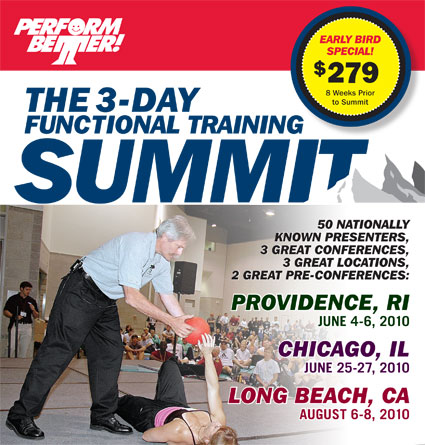 This past weekend, I attended the Perform Better Functional Training Summit in Providence Rhode Island. I believe this one was my 5th or 6th Summit that I have attended. I really think that year to year, Chris Poirier and his staff do a great job putting together great educational opportunities. In my opinion, the 2010 Rhode Island Summit may have been one of the best.
This past weekend, I attended the Perform Better Functional Training Summit in Providence Rhode Island. I believe this one was my 5th or 6th Summit that I have attended. I really think that year to year, Chris Poirier and his staff do a great job putting together great educational opportunities. In my opinion, the 2010 Rhode Island Summit may have been one of the best.
I think the best way to judge if a seminar was really good or not is by reflecting on how much knowledge you learned and more importantly, where you can make some adjustments in your programs. I don’t think that it’s a good idea to just learn a new exercise and throw it in somewhere without any reason to do so. However, if I can learn a new progression, or sometimes a regression that makes sense and can help my athletes get better, I am all for it. Here are some highlights of who I saw speak and what I took away from the presentations during Day 1:
Steve Cotter- Steve is a Kettle bell guy who walks the walk and talks the talk. Steve came up to Anaheim for a 3 hour practical where I learned how to teach the kettle bell lifts such as the Swing (double and single arm), Snatch, Clean, and Clean and Jerk. Steve pretty much went over those lifts to a crowd of over 100 people. Some good information that I was reminded of and took away includes:
– Starting the swing or snatch with your hand in a neutral position (as opposed to overhand) and also some techniques to avoid ripping your hands apart when doing multiple reps.
– Steve advocates competition style kettle bell lifting where he does reps up into the 100’s.
Mike Boyle- Mike gave his presentation on the joint by joint approach to warm up. Although I think I may have seen this before, I really enjoy seeing Mike present live. He is really funny and isn’t afraid to say what’s on his mind. Some of the things that I picked up include:
– I need to do more hip internal rotation with my athletes
– Hip and Thoracic spine mobility are key. (Sue Falsone gave a talk on T-spine mobility which I will review later)
– Mike does a good job of incorporating some of the tri-planar movements into his warm up. I like the progression and it is something that I have done with my athletes but have gotten away from. We need to do more of that.
Fraser Quelch- This was the first time that I have seen Fraser speak. He did a great job. Some of the things I took away from it include:
– “Balance is the ability to control the position that we are in”. That quote kind of stuck to me.
– The plank is a reactive exercise to gravity.
Al Vermeil- Al is the best, period. I love seeing him speak as his passion for training is really noticeable during his talks. Some great information that I got from Al:
– Ankle, Knee, and Hip (triple) extension is the most important thing in sport
– Coaches must keep training. You must be able to do what you are asking your athletes to do.
– Look at training programs like you would at investing money
– Never get too far away from speed work
– Ask yourself- “Am I doing a good job, or is there something I can do better?”
John Berardi- John gave a great talk on nutrition for injury recovery. This was a good talk for me to see I it really opened up my eyes to the importance of nutrition during the recovery process.
– For fat loss, John recommends 1 gram per percent of body fat on a daily basis for the first 2 weeks
– Most everyone is deficient in Vitamin D
– Fish Oil and Flax Seed are not the same. John recommends taking both.
– Eating fish on a regular basis isn’t the same as taking fish oil supplements.
Thomas Plummer- Thomas Plummer is a great presenter. He really gives a kick in the butt to all of the attendees. This year, Thomas profiled some of the people who were speaking at the Summit including Boyle, Cook, Alwyn Cosgrove, Rachel Cosgrove, Todd Durkin, and Chris Poirier. He outlined what makes these people successful and why they are considered to be at the top of our profession. It was really inspiring for me as I have lots of respect for all of them as professionals. Here are some other tidbits I took from Thom’s talk:
– Thom believes that every 4 months, you should project your life 3 years. What does my work/life mean? How much money am I making? Where do I live?
– One on one training is in-effective in making money and running your business successfully
– Some of the quotes that I liked in the talk from some of the professional who were profiled include: “It’s not what you know; it’s what you can get someone else to do.”- Boyle. “Listen, practice, study, and apply- again and again- then talk.”- Cook. “Dedication and hard work will get you some sort of success; however caring will get you happiness.”- Poirier
The first day was great. I really picked up a lot of information that I can use with my athletes now. Day 2 and 3 of the Summit were just as good. I will review the rest of the Summit in a few days. Thanks for reading.
I was recently on a flight from Long Beach to Boston. On the flight, I watched the movie “Invictus” which starred Morgan Freeman and Matt Damon. Morgan Freeman’s character was Nelson Mandela, while Damon’s character was the captain of the South African rugby team named, Francois Pienaar. In the movie, they both met for tea where Mandela was getting to know more about Pienaar’s leadership philosophy. Mandela asked “How do you lead the rugby team?” Pienaar’s answer was “By example”.
Of course, I have and you have most likely heard this before, but hearing it again, prompted me to write and post this. I really think it is crucial for any leader of any group/organization to lead by example. For example, in sport, captains of any team need to lead by example. They don’t necessarily have to be rah-rah type leaders, but they must lead by example in terms of character, work ethic, professionalism, etc.
In our business, I also think it is crucial for the strength and conditioning coach or personal trainer to lead by example. For example, are you able to complete the workout that you are asking your athlete/client to do? Have you experienced what they have? Do you look the part? Are you in adequate condition?
For me personally, I am realistic in knowing that I get to work with some of the most elite athletes in the entire world. I will probably never be in the type of condition (strength, power, speed, anaerobic, aerobic). However, I will do my best in trying to experience what these guys go through. I will try to get in the best condition that I possibly can so that my athletes will see me as leading by example. What do I do? I try to adhere to a healthy lifestyle where fitness and proper nutrition are important. Also, I play pick up hockey once a week and I have recently signed up for a hockey league. What do you do?
This is a guest blog post from my wife Hillary. She wrote this and posted it on her blog at www.HillarySkahan.com.
Do you find yourself standing in the fridge trying to decide what you should eat for lunch while your stomach growls “HURRY UP!”? Or, does the 3 o’clock hour roll around and you dive recklessly into the cupboard devouring anything in site? Unplanned binges or splurges can ruin your diet simply because you didn’t know what you were going to eat for your next meal. You didn’t plan for success.
As moms, we are always preparing our children for what is to come next in their day. We tell them if they are good in the store we will go to the park later. We persuade them to sit nicely at dinner and eat all their veggies so they can have dessert. We set them up for success and rewards. These same tactics need to be applied to ourselves.
I think the hardest group of women to keep on track diet wise is the stay at home mom or the woman who works from home. When you spend the majority of your day at home, it is so easy to think, “I will just eat when I am hungry, no need to plan.” This can be a diet wrecker. What typically happens is, hunger sets in and quickly becomes starvation mode. Poor choices are made and regretted later. Here are 5 rules to follow and use as your bible when it comes to nutrition.
Tips for successful eating:
1. Plan all your meals the night before even if you aren’t leaving the house the next day.
2. Tupperware is in your house for a reason, not just for leftovers. Put all your meals, except for dinner with your family, in those containers. Plan for Success and it will happen.
3. If the food isn’t in the Tupperware don’t eat it! It wasn’t planned.
4. Water- buy a Sigg or a Life Factory glass water bottle, keep it filled and on your counter. Don’t drink anything with more than 0 calories in it.
5. Get out of the kitchen. My grandmother use to say the kitchen was closed after meals. Adopt this phrase and don’t linger where temptation lurks. A handful of this or a handful of that can blow a diet.
Plain and simple, 5 tips to keep your diet on track. Break any bad habits now. We preach to our children all day long why they should or shouldn’t do something. I think all moms want their children to grow up and make good choices. It’s time for mom’s to make good choices, why should it stop when you become a mother? Believe what you teach and teach what you believe.

